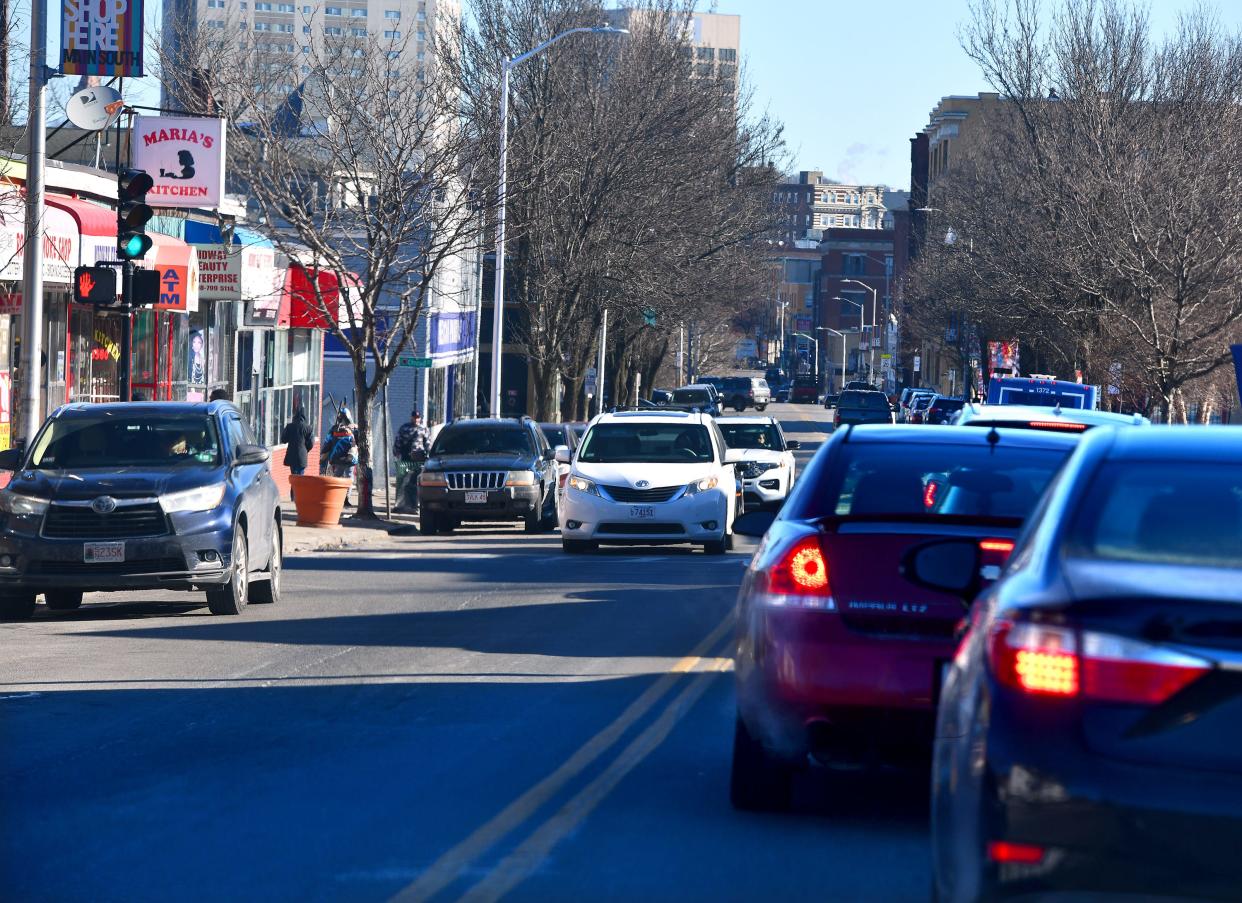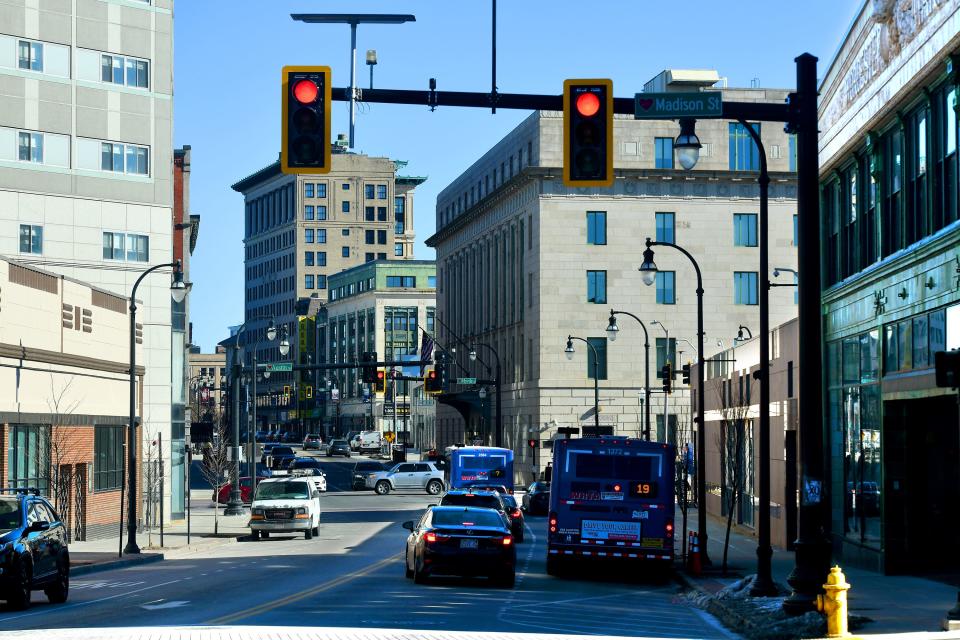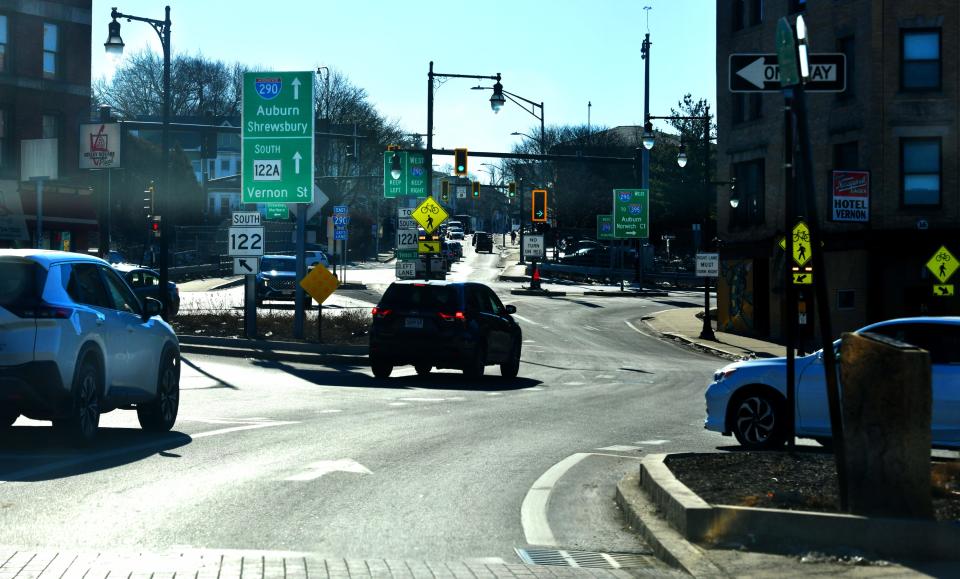Many Worcester residents don't have cars: Time for city to refocus its transportation?

WORCESTER – We are a car culture. For many of us, to get from point A to B, we hop in the car and get to where we want to go.
But why is Worcester’s transportation grid so car-focused when a sizeable portion of city residents don’t have wheels?
“Great question,” said Stephen Rolle, commissioner of the city’s Department of Transportation and Mobility. “We’re trying to address it with the mobility action plan.”
Before delving into that plan and others aimed at diversifying the city’s grid, a few statistics highlight what Worcester faces: A significant number of residents without cars that need safe, reliable transportation options.
● 26% of all renters in Worcester and 17% of residents citywide don’t own or have access to a private automobile
● Those percentages climb sharply in the downtown area: 41% of renters and 38% of all residents don’t have access to a private vehicle
The information to crunch those percentages comes from the U.S. Census and the reasons for not owning a car can include that it is too expensive for a family’s budget, dense streets create no room for the family car or it could be a conscious decision to walk, bike or take a bus to lower one’s carbon footprint.

More work to do
City Hall acknowledged there’s more work to do to expand the city’s non-car options. To not only increase walking and bike paths and public bus service but also make sure those options are safe and reliable.
“It’s important we start to develop more robust travel options for people,” said Rolle.
Eric Stratton couldn’t agree more. When he lived in Boston, Stratton could bike daily to work. Since he moved to Worcester, that’s not the case. Part of the reason is Stratton has less time because he’s now a family man with young kids. But Stratton, who has lived in Worcester for six years and belongs to several local bicycle clubs, wished the city had a more robust network for cyclists.
“The issue is the safety aspect of the road infrastructure in Worcester is not well designed for bike or pedestrian safety at this time,” Stratton said.
Susan Berry bikes around Worcester, and while she said cars generally make room when she’s pedaling around town, some drivers don't have a lot of patience to share the road with cyclists.

As Berry sees it, the city should consider several steps to protect cyclists including lowering speed limits for cars, increased policing and enforcement to protect cyclists, and more education so the public understands that bikes and pedestrians have a place on the roads.
"I don't feel like the city provides an environment that encourages people who are not risk takers," said Berry. "Friends that have kids say, 'No way I'm getting out there.' If the attitude is you're taking your life in your hands if you walk or bike, something is wrong with our system or community and the way it's functioning so people don't feel safe with anything beyond buying a car."
How did we get here?
Historically, U.S. cities were designed for car travel and Worcester is no different. Also, some neighborhood residents without cars didn’t have a seat at the table when the nation’s cities designed their transportation systems.
Overhauling Worcester’s grid will take time and how much it’s going to cost is undetermined.
“Ultimately, so many infrastructure investments are needed. It’s a long-term investment and I cannot give a (cost) number,” said Michelle Smith, the city’s planning director. Smith’s office is leading the charge to develop a long-range plan for the city called Worcester Now|Next that includes expanded transportation options.
Smith did give one cost figure, an estimated total of $1 million over the next three years to overhaul the city’s zoning rules including those that generally mandate two parking spots for each residential unit constructed.
That requirement is a hot-button issue not only for real estate developers but also for city residents as Worcester explores lowering or eliminating the parking requirement in some cases. The result could mean fewer cars on the roads and more routes for walking, biking and bus transit.
Plan details: Goal is to deliver more options
Several plans are in the works simultaneously to improve and expand the city’s transportation options to meet the challenges of the 21st century, including the risks posed by climate change that put a premium on non-carbon emitting travel to limit greenhouse gases that warm the planet.
Now|Next is the driver for the plans. The two-year effort recently resulted in a draft plan. Public comment wraps up this week and Smith said one of the plans immediate steps is implementation of the city’s mobility action plan.
Led by Rolle, the plan is expected to be in draft form in May and finished this summer. Its focus is not only relaxing the two-parking spot ordinance for each residential unit built but also expanding the city’s network of bike and walking paths and public bus service.
Worcester: Behind other communities
“We are behind our neighboring cities in developing bike facilities," said Rolle. Of the more than 600 miles of roads in Worcester, Rolle said 17 miles have paths and other infrastructure for cycling.
On the walking front, Rolle said 60% to 70% of roads in Worcester have sidewalks. To improve their condition for walkers, his department is taking an inventory of streets and sidewalks citywide to identify needed improvements. Staff are also developing a checklist of traffic signals citywide to prioritize maintenance and upgrades.
Rolle noted he has seen a proliferation of scooters on city streets and mentioned that conversations about bike and scooter sharing in Worcester will likely take place. Ofo, the dockless bike-share giant that populated city streets in 2017 with its bright yellow rental bicycles, shut down its operations in Worcester in early 2018.
Precedent for change
As for taking a fresh look at the two-parking spot requirement that is a part of plans to diversify transportation options in Worcester, there is precedent for change. Buffalo, with a population like Worcester north of 200,000 residents, was the first relatively large city in the U.S. to eliminate off-street parking minimums. That happened in 2017 and other cities followed suit.
Rolle and Smith noted that reduction and elimination of the two-spot ordinance could make sense for some developments and in certain neighborhoods. Any change requires City Council approval.
Rolle is looking at the parking ordinance with an analytical lens. He mentioned parking requirements on every lot are detrimental in several ways including reducing the amount of property that can be developed for productive use; creating environments dependent on cars at the expense of developing walking and transit options; and that parking spots lead to less tax revenue from properties that ultimately increases tax payments for others in the city.
In addition, parking mandates spike development costs that are transferred to residents in the form of higher rents and other expenses. There’s also inefficiency when every property must have its own parking lot, said Rolle, because it is often vacant or underused. Centralized parking in shared lots or garages is more efficient, he said.
Smith and Rolle noted that market forces could help drive parking requirements, not strict ordinances. However, the city needs to tread carefully.
“We have to be careful that we’re not overly rigid, not have too high a parking requirement,” said Smith. “Our goal is better coordination of land use and transportation planning.”
Worcester: 'Late to the game'
Karin Valentine Goins is excited about Now|Next, the mobility action plan and other city efforts like the Complete Streets and Vision Zero programs to increase transportation safety and options.
Launched this week in Worcester with a grant from the U.S. Department of Transportation, Vision Zero will focus on road design and management to reduce car accidents. The city reported 43 deaths in car accidents in Worcester and 478 seriously injured over the past five years.
Goins has lived in Worcester for 25 years and co-founded WalkBike Worcester to promote walking and biking in the city. However, she mentioned that Worcester was “perhaps late to the game,” to diversify beyond a transportation system dominated by cars.
Goins is optimistic the city is moving in the right direction and noted the redesign of Mill Street as an example of a road once dubbed “The Speedway” that now includes fewer car lanes that should combat reckless speeding. There is also a dedicated bike lane.
Meanwhile, a "game changer" is what Goins called the MassBike program, which delivered 100 electric bicycles to low-income residents in Worcester.
Reality check: Will Worcester achieve its goals?
Plans and visions are one thing, but how realistic is it that Worcester will have the will and the money to expand the city’s transportation options, especially in a culture where the car is king?
Stratton, the Boston transplant to Worcester, is optimistic about bikes and walkers becoming a greater presence in the city. “I would love to see us get there. It will definitely take time. We’re creatures of habit and we keep designing infrastructure that encourages us to drive.
“But we have to look to set up infrastructure. If it makes us feel safe and convenient to use other modes of transportation, then people would be encouraged to do so.”
Goins is optimistic the city will move beyond a car grid and give residents more options, but added, “I wish it could go faster.
“Building the infrastructure will take a while. It’s going to take a combination of persistence and holding officials accountable," she said.
Contact Henry Schwan at henry.schwan@telegram.com. Follow him on X: @henrytelegram.
This article originally appeared on Telegram & Gazette: Some say time for city to refocus with many residents without cars

